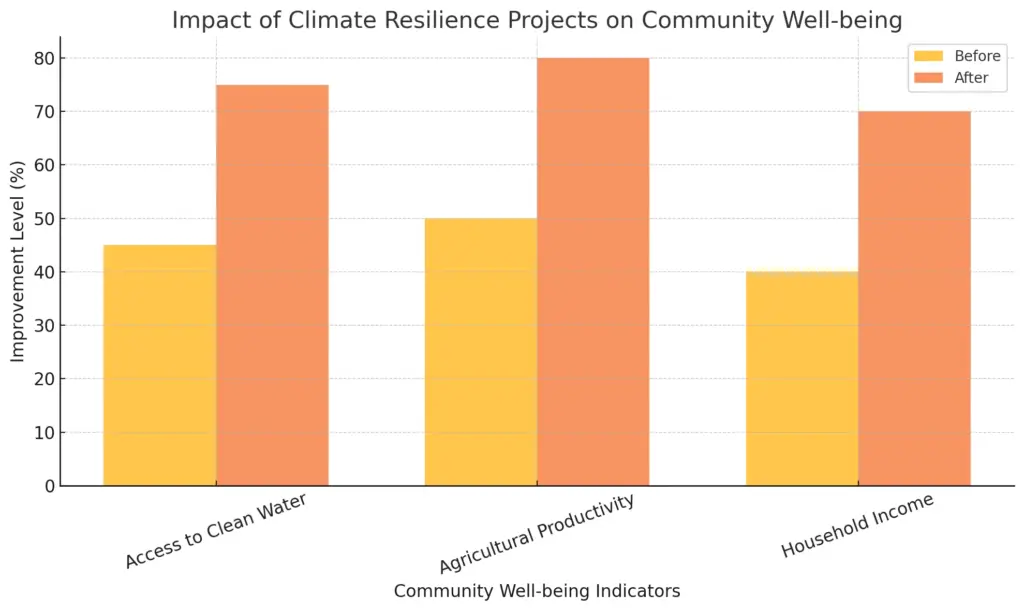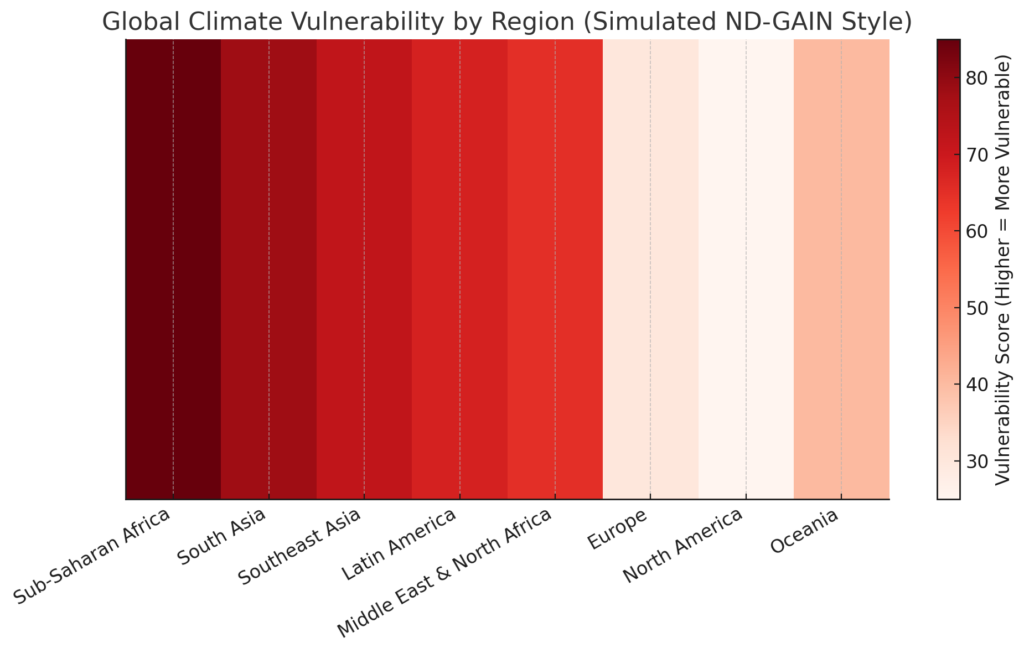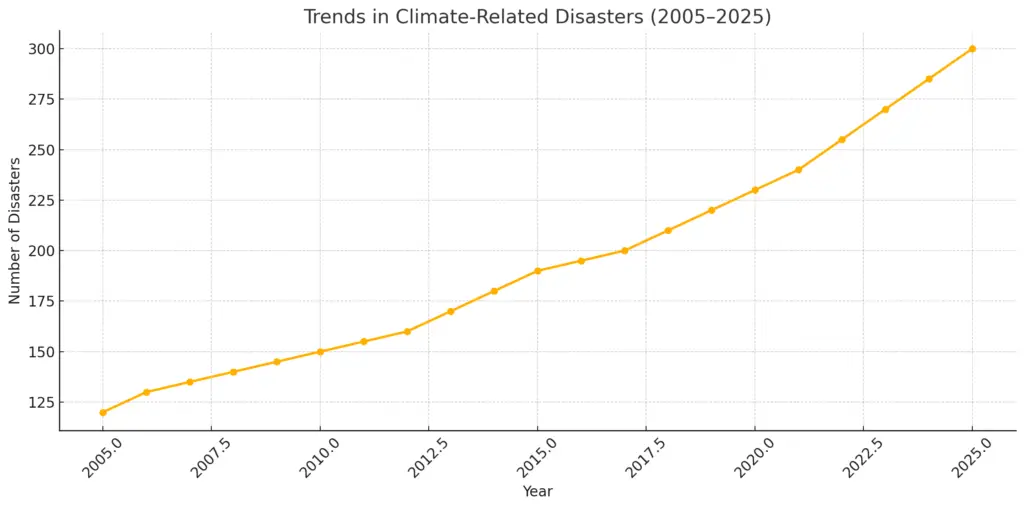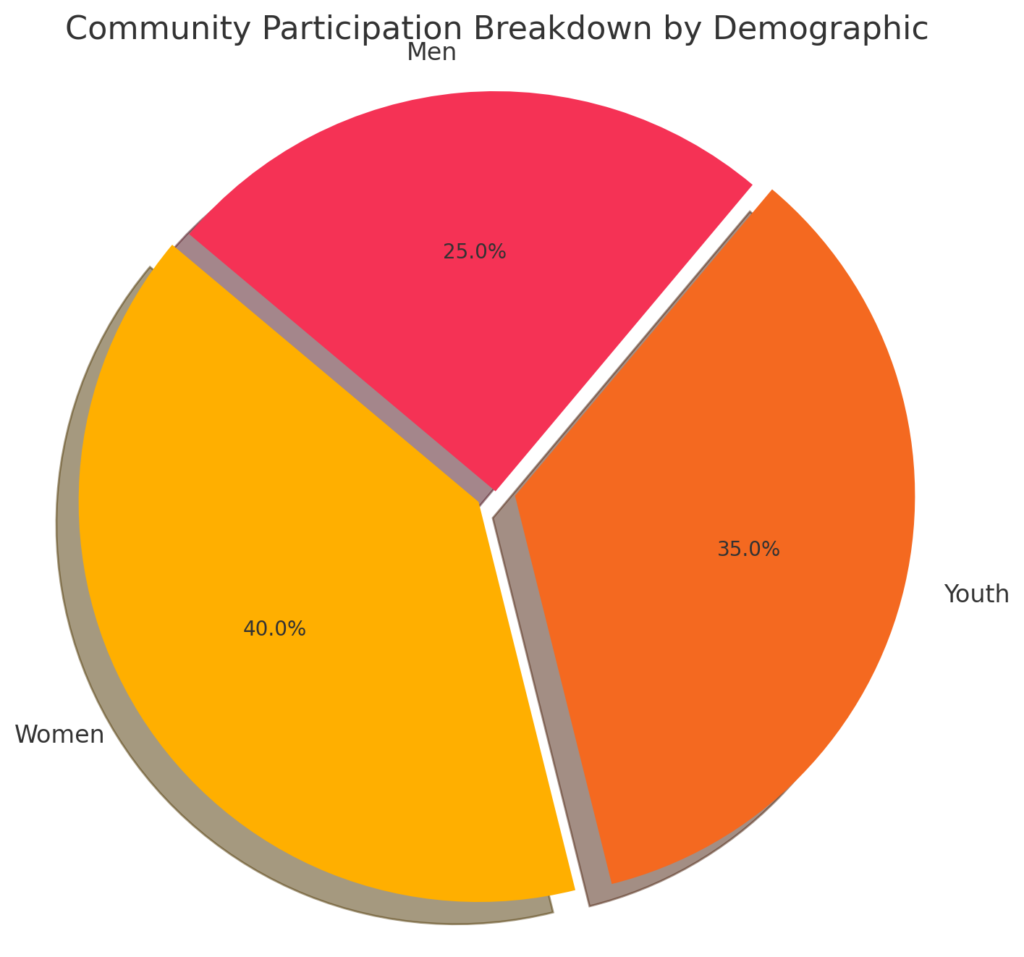(1) Introduction
Building climate resilient communities is crucial in today’s world as climate change increasingly threatens ecosystems, infrastructure, and human livelihoods. Communities around the globe, particularly in vulnerable regions, face rising sea levels, unpredictable weather patterns, and frequent natural disasters. To combat these challenges, building climate-resilient communities through well-structured field projects has become essential.

This chart shows the positive impact of climate resilience field projects on community well-being across three critical indicators:
- Access to Clean Water improved from 45% to 75%
- Agricultural Productivity jumped from 50% to 80%
- Household Income rose from 40% to 70%
Field projects not only enhance community preparedness but also empower local populations with the knowledge and tools needed to adapt to environmental changes. By integrating sustainable practices, community participation, and indigenous knowledge, these projects create lasting resilience and foster collective action against climate risks.
This article on “Building Climate Resilient Communities” will share practical strategies, challenges, and real-life lessons learned from field projects dedicated to building climate resilient communities. Whether you are a development professional, policymaker, or community leader, the insights shared here will help you shape effective resilience strategies.

(2) Understanding Climate Resilience
(2.1) What is Climate Resilience?
Climate resilience refers to the capacity of communities and ecosystems to anticipate, prepare for, respond to, and recover from climate-related hazards. It involves reducing vulnerabilities while enhancing adaptive capacities to deal with climatic events.

This heat map ranks global regions based on climate vulnerability, with darker red shades indicating higher risk:
- Sub-Saharan Africa and South Asia are among the most vulnerable.
- Europe and North America are less vulnerable due to stronger infrastructure and adaptive capacity.
Building climate resilience requires a holistic approach that includes social, economic, and environmental dimensions. It emphasizes community involvement and prioritizes sustainable practices to reduce long-term risks.
(2.1.1) Social Adaptation: Empowering local communities to participate in decision-making.
Social adaptation plays a crucial role in building climate resilient communities by fostering an inclusive approach where local voices are heard and valued. Empowering communities to participate in decision-making not only builds trust but also ensures that solutions are practical and culturally relevant.
a. Community-Led Decision-Making
One of the core principles of social adaptation is allowing communities to take the lead in planning and executing resilience strategies. This can be achieved by:
- Forming Community Committees: Establishing local groups that consist of community leaders, youth representatives, and women advocates.
- Participatory Planning Workshops: Engaging community members in hands-on sessions to brainstorm solutions and develop action plans.
- Feedback Mechanisms: Regularly collecting input from community members to assess the effectiveness of ongoing projects and adapt strategies as needed.
b. Inclusive Leadership Training
Leadership development among local stakeholders ensures that community voices are genuinely represented. Programs focusing on leadership skills, communication, and conflict resolution empower people to take ownership of resilience initiatives.
For example, in Bangladesh, local community leaders trained under the GO4IMPact Programme successfully advocated for climate-smart agriculture practices, transforming traditional farming methods into more resilient models.
c. Addressing Social Inequities
Climate resilience should not only focus on environmental measures but also address social inequalities that hinder adaptation efforts. Special attention should be given to:
- Marginalized Communities: Ensuring that vulnerable groups such as women, youth, and indigenous populations are part of decision-making processes.
- Capacity Building for Women: Offering training to women on sustainable practices and leadership roles to foster gender-inclusive resilience strategies.
By prioritizing social adaptation, communities can better prepare for and respond to climatic challenges while strengthening social cohesion and equity.
(2.1.2) Economic Stability: Promoting sustainable livelihoods that can withstand climatic shocks.
Economic stability is a foundational element of climate resilience, as communities facing financial insecurity are more vulnerable to climate impacts. Promoting sustainable livelihoods helps communities not only withstand climatic shocks but also thrive in the long term.
a. Climate-Smart Livelihood Opportunities
Investing in climate-smart agriculture, eco-friendly businesses, and green technologies can bolster economic resilience. Communities that adopt such practices often experience increased economic stability while simultaneously mitigating environmental risks.
Examples of Climate-Smart Livelihoods:
- Organic Farming: Reduces dependency on chemical inputs and improves soil health.
- Agroforestry: Combines agriculture with tree planting to enhance biodiversity and soil quality.
- Renewable Energy Businesses: Community-led solar and wind power projects reduce reliance on fossil fuels.
b. Skill Development and Vocational Training
Training programs that equip community members with skills in sustainable resource management and green entrepreneurship are crucial for long-term economic stability. This can include:
- Technical Training: Learning to install and maintain renewable energy systems.
- Business Management Workshops: Helping local entrepreneurs develop eco-friendly business models.
- Financial Literacy Programs: Teaching community members how to access microloans and manage sustainable projects.
c. Public-Private Partnerships (PPPs)
Collaborating with private sectors and government agencies can boost financial support and technical assistance. Successful PPP models often involve:
- Investment in Green Infrastructure: Creating jobs while enhancing environmental resilience.
- Community Cooperatives: Mobilizing local resources to build and maintain eco-friendly enterprises.
- Support from NGOs and International Donors: Ensuring financial backing for long-term sustainability projects.
Promoting sustainable livelihoods not only secures the community’s financial future but also reduces their vulnerability to climate-related disruptions.
(2.1.3) Environmental Sustainability: Implementing practices that protect and restore ecosystems.
Environmental sustainability is at the heart of building climate resilient communities. Implementing practices that restore degraded ecosystems and conserve natural resources is essential to maintaining long-term resilience.
a. Ecosystem-Based Adaptation (EbA)
This approach leverages natural systems to reduce climate vulnerabilities and increase adaptive capacities. It includes:
- Wetland Restoration: Enhancing natural water filtration and flood control.
- Mangrove Rehabilitation: Protecting coastal areas from storm surges and soil erosion.
- Forest Conservation: Preserving biodiversity and carbon sinks.
Example: In Cox’s Bazar, Bangladesh, restoring coastal mangroves not only protected the coastline from erosion but also provided habitats for wildlife, thereby strengthening local biodiversity and resilience.
b. Sustainable Resource Management
Communities need to manage their natural resources wisely to avoid degradation and ensure long-term productivity. This involves:
- Integrated Water Resource Management (IWRM): Efficient use and conservation of water resources.
- Soil Conservation Techniques: Preventing erosion and maintaining soil fertility through mulching and crop rotation.
- Biodiversity Conservation Initiatives: Protecting native species and maintaining healthy ecosystems.
c. Community-Led Environmental Monitoring
To ensure ongoing sustainability, communities should be actively involved in monitoring their local ecosystems. This can be done through:
- Participatory Environmental Audits: Local groups evaluating the health of their natural resources.
- Citizen Science Projects: Encouraging community members to collect data on weather patterns, biodiversity changes, and land degradation.
- Youth Engagement in Monitoring: Involving young people in tracking environmental changes and reporting issues.
d. Pollution Reduction and Waste Management
Improper waste disposal and pollution significantly impact ecosystems and human health. Communities can adopt sustainable waste management practices such as:
- Waste Segregation and Recycling: Reducing landfill use and promoting resource recovery.
- Community Clean-Up Initiatives: Organizing regular drives to remove plastic waste and debris from local environments.
- Biodegradable Solutions: Encouraging the use of compostable materials and reducing single-use plastics.
By prioritizing environmental sustainability, communities not only protect their natural surroundings but also build a stronger foundation for climate resilience. Integrating community-driven conservation practices with modern technologies leads to robust and lasting solutions.
(2.2) The Significance of Community-Based Resilience Strategies
Community-based strategies are crucial for fostering climate resilience as they:
- Empower Local Action: Engage residents to take ownership of resilience strategies.
- Leverage Indigenous Knowledge: Utilize traditional practices for sustainable adaptation.
- Promote Collective Problem-Solving: Foster a sense of shared responsibility and cooperation.
By involving community members directly, these strategies ensure that solutions are culturally relevant and practical.
(3) Challenges in Building Climate Resilient Communities

This graph illustrates the rising trend of climate-related disasters from 2005 to 2025, emphasizing the escalating climate risks:
- The number of disasters increased steadily from 120 events in 2005 to 300 events in 2025.
- This supports the urgency of proactive climate resilience initiatives, making it perfect for your introduction section to set the tone.
Despite the importance of climate resilience, communities face numerous challenges in implementing effective strategies. Below are some common obstacles and ways to overcome them:
(3.1) Social and Cultural Barriers
Many communities face resistance to change, especially when traditional practices are deeply rooted. Building climate resilient communities requires gaining community trust and ensuring cultural sensitivity.
Solution: Involve local leaders and respected figures to advocate for resilience initiatives.
(3.2) Economic Constraints
Lack of financial resources often hinders the implementation of resilience strategies, especially in low-income regions.
Solution: Seek funding from international organizations and develop community-driven business models that promote sustainable practices.
(3.3) Technical Limitations
Communities may lack expertise in climate adaptation technologies and data-driven decision-making.
Solution: Conduct training programs on data collection, analysis, and the use of GIS and remote sensing for environmental monitoring.
(3.4) Governance and Policy Issues
Weak governance frameworks can result in fragmented efforts and inadequate support for community-driven projects.
Solution: Advocate for policy changes that promote inclusive climate action and engage local government stakeholders from the start.
(4) Proven Strategies for Climate Resilient Communities
(4.1) Community Participation and Capacity Building

This visual breaks down community participation in climate resilience projects:
- Women: 40%
- Youth: 35%
- Men: 25%
Actively involving community members in both the planning and execution phases of climate resilience projects is fundamental to ensuring their success. Communities that feel included are more likely to take ownership of the initiatives, maintain them over time, and pass on knowledge to future generations.
a. Why Participation Matters
When communities are treated as active stakeholders rather than passive beneficiaries, they contribute valuable insights that reflect local realities and cultural nuances. This localized understanding can dramatically improve the design, relevance, and impact of climate adaptation strategies.
Examples of participation mechanisms include:
- Community Consultations and Focus Groups: Engaging diverse members—youth, women, elders, and marginalized groups—before finalizing project plans.
- Decision-Making Committees: Establishing local steering groups responsible for guiding project implementation and monitoring.
- Feedback Loops: Creating systems for ongoing input, allowing the community to shape and adjust the project dynamically.
b. Role of Youth and Women
Mobilizing youth networks is particularly powerful, as young people bring energy, creativity, and a deep sense of ownership. Youth-led climate campaigns, tree-planting drives, and environmental education programs have proven effective in building awareness and promoting change at the grassroots level.
Similarly, empowering women in resilience-building efforts enhances both social equity and project outcomes. When women are trained in climate-smart agriculture, water resource management, or renewable energy systems, the entire community benefits from their leadership and innovation.
c. Long-Term Capacity Building
Capacity building should go beyond one-time workshops. Sustainable knowledge transfer requires:
Access to Resources: Providing toolkits, digital platforms, and follow-up mentorship for ongoing learning.
Continuous Learning Opportunities: Establishing training-of-trainers (ToT) models to cascade skills.
Peer-to-Peer Learning: Encouraging communities to share success stories and lessons across regions.
(4.2) Training and Empowerment

This flowchart-style infographic outlines the 5 essential steps for rolling out community-led climate resilience projects:
- Community Assessment – Understanding local needs, risks, and resources.
- Resilience Planning – Co-designing strategies with community input.
- Capacity Building & Training – Educating and empowering local actors.
- Project Implementation – Executing the plan with local ownership.
- Monitoring & Evaluation – Tracking progress and making improvements.
Training is more than just delivering information—it’s about empowering individuals to lead change within their communities. Training programs should be participatory, practical, and tailored to local needs.
a. Focus Areas for Training
Effective training programs cover a range of topics depending on the local context, such as:
- Water Conservation: Techniques like rainwater harvesting, drip irrigation, and greywater recycling.
- Climate-Smart Agriculture: Drought-tolerant crops, integrated pest management, and agroforestry.
- Disaster Preparedness: Emergency response planning, early warning systems, and first aid.
b. Building Leadership Through Education
Workshops and community training should aim to:
- Boost confidence and communication skills.
- Teach problem-solving and critical thinking.
- Encourage innovation by letting participants design local solutions.
Case Example: In the Naogaon region of Bangladesh, a project supported by WaterAid and Swisscontact provided hands-on training to over 10,000 people on integrated water resource management. Many of these trained individuals went on to lead local initiatives, showing how empowerment can trigger a ripple effect.
c. Measuring Impact
The success of training and empowerment initiatives can be assessed by tracking:
Emergence of local champions and self-sustaining initiatives.
Behavioral changes in households and farming practices.
Increased community engagement in local governance.
(4.3) Integrating Indigenous Knowledge and Modern Techniques
Indigenous knowledge, passed down through generations, is a valuable resource for climate adaptation. It reflects a deep connection to the land and natural rhythms, often providing cost-effective and sustainable solutions.
a. Traditional Knowledge in Practice
Some common traditional practices include:
- Floating Gardens (Baira): Used in flood-prone areas of Bangladesh to grow vegetables.
- Terracing and Contour Farming: Prevents soil erosion in hilly regions.
- Natural Indicators: Observing animal behavior or plant blooming patterns to predict weather changes.
These time-tested practices are often more sustainable and culturally acceptable than imported technologies.
b. Blending the Old and the New
To maximize effectiveness, it’s important to integrate indigenous wisdom with modern scientific tools. Examples include:
- GIS Mapping + Local Hazard Memory: Merging spatial data with oral histories of floods or droughts to identify risk zones.
- Remote Sensing + Traditional Agriculture: Using satellite data to inform planting schedules and resource allocation.
Project Insight: In the Barisal division of Bangladesh, climate adaptation efforts incorporated both scientific data from meteorological services and local farmers’ planting schedules—resulting in improved crop yields and resilience to erratic rainfall.
c. Building Respect and Mutual Learning
Successful integration depends on mutual respect and co-learning. Development professionals and researchers must approach indigenous communities with humility and a willingness to listen. Community members should be encouraged to test and adapt innovations, making them their own.
Key Benefits of this Approach:
- Strengthens cultural identity and resilience.
- Encourages community ownership.
- Ensures sustainability by aligning with existing practices.
(5) Real-Life Case Studies and Success Stories
(5.1) Community-Based Water Management in Bangladesh
This project mobilized local communities to adopt rainwater harvesting techniques, significantly reducing water scarcity during dry seasons. The integration of indigenous practices with modern technology made the project sustainable and community-driven.
(5.2) Climate Action through Youth Mobilization
Youth-led climate initiatives have shown remarkable success in raising awareness and implementing local adaptation measures. For example:
- Leadership Training: Empowered youth groups to initiate tree-planting campaigns.
- Advocacy Campaigns: Engaged students and young professionals in climate activism.
(5.3) Eco-Friendly Business Models
Encouraging local entrepreneurs to adopt sustainable practices, such as organic farming and waste recycling, has proven effective in creating economic resilience while promoting environmental stewardship.
(6) Integrating Indigenous Knowledge
(6.1) Why Indigenous Knowledge Matters
Traditional knowledge systems often hold invaluable insights into sustainable living and adaptation strategies. For example:
- Water Conservation Techniques: Using traditional rainwater harvesting methods.
- Sustainable Agriculture: Implementing crop rotation and organic farming practices.
(6.2) Blending Traditional and Modern Approaches
Combining indigenous wisdom with modern innovations results in robust solutions. For instance:
- Community Mapping Projects: Integrating GIS technology with local knowledge to identify vulnerable areas.
- Hybrid Farming Techniques: Combining local farming practices with climate-smart agriculture.
(7) Climate-Resilient Practices to Adopt
Implementing practical solutions is essential for building climate resilient communities. Here are a few practices that have proven successful:
| Practice | Impact |
|---|---|
| Sustainable Water Management | Reduces drought risk and ensures water availability |
| Biodiversity Conservation | Enhances ecosystem services and community well-being |
| Disaster Preparedness Training | Improves response times and mitigates loss |
| Climate-Smart Agriculture | Increases food security and economic stability |
| Renewable Energy Implementation | Reduces carbon emissions and promotes energy independence |
(8) Tools and Techniques for Monitoring Resilience
Monitoring climate resilience requires data-driven approaches, such as:
- GIS and Remote Sensing: Track land use changes and identify vulnerable areas.
- Community Surveys: Collect local insights to understand community needs.
- Mobile Data Collection: Gather real-time information from the field.
(9) Building Community Awareness and Advocacy
Raising awareness is critical to fostering long-term resilience. Communities can be engaged through:
- Educational Workshops: Teach sustainable practices and adaptation techniques.
- Public Campaigns: Use social media and local media to spread awareness.
- Youth Engagement Programs: Mobilize the next generation as climate advocates.
(10) Future Perspectives and Recommendations
To enhance the success of climate resilience projects, consider:
- Scaling Up Successful Models: Replicating proven strategies in other communities.
- Policy Support: Advocating for government policies that encourage local action.
- Innovation and Research: Continuously exploring new methods to address emerging challenges.
(11) Conclusion
Building climate resilient communities is an ongoing journey that demands collective effort, innovative solutions, and strong community engagement. By leveraging lessons learned from field projects, communities can better withstand climate shocks and build a sustainable future. Whether through youth mobilization, integrating indigenous knowledge, or adopting climate-smart practices, resilience is achievable with commitment and collaboration.
Frequently Asked Questions (FAQs)
1. How can communities become more climate resilient?
By adopting sustainable practices, engaging stakeholders, and mobilizing community action through field projects.
2. What role do youth play in building climate resilience?
Youth mobilization fosters innovation, advocacy, and community-driven solutions.
3. How do field projects contribute to community adaptation?
They implement practical solutions and build local capacities to cope with climatic challenges.
4. What challenges are commonly faced during climate resilience projects?
Social resistance, financial constraints, technical limitations, and governance issues.
5. How can modern technology assist in building resilient communities?
Using GIS, remote sensing, and data-driven monitoring enhances adaptation strategies.
6. What are some successful examples of climate-resilient communities?
Bangladesh’s community-based water management and youth mobilization projects are great examples.





